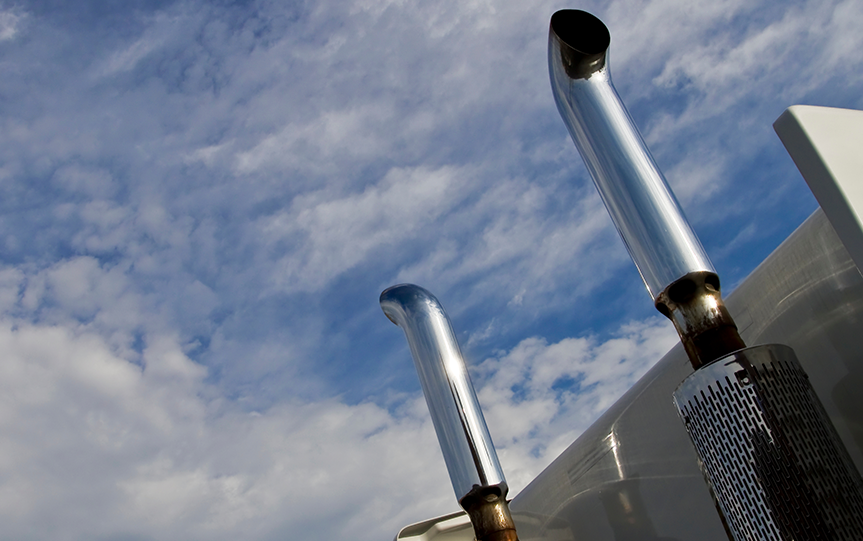
Visit Our Sponsors |
|
|
|
|
|
|
|
|
|
|
|
|
|
|
|
|
|
|
|
|
|
|
|
|
|
|
|
|
|
|
|
|
|
|
|
|
|
|

Photo: Getty.
In April, the U.S. Environmental Protection Agency turned up the heat on commercial truckers, proposing more stringent standards for greenhouse gas emissions (GHG) from heavy-duty vehicles, beginning in model year 2027. The action signaled a move by the Biden Administration from “a nudge in the right direction to a firm push.”
That’s how attorney Joe Trione, shareholder and head of the Power and Renewables Team of Baker Donelson, describes the EPA’s latest move to steer the nation toward a more sustainable energy economy, through a shift to zero-emission vehicles.
The new proposal goes beyond EPA’s “Phase 2” fuel-efficiency standards for light, medium and heavy-duty trucks. Finalized in 2016, they were intended to lower carbon dioxide emissions by an estimated 1.1 billion metric tons, and cut nationwide oil consumption by up to 2 billion barrels over the lifetime of vehicles sold under the program. The new standards would increase cuts in GHG emissions by heavy-duty vehicles to 1.8 billion metric tons between 2027 and 2055, the agency says.
According to EPA, the Phase 3 standards “would significantly reduce carbon emissions from heavy-duty vehicles and, from the increased use of zero-emission vehicle technology projected in the proposal, would also reduce emissions of smog and soot-forming pollutants and help to address the challenges of global climate change and air pollution in communities near major roadways.”
The ultimate aim of the proposal is to encourage the transition to zero-emission vehicles, or ZEVs (although EPA is careful not to mandate which technology truck producers should use to achieve that goal). The agency lays out “one potential pathway” for industry to meet the proposed standards by model year 2032, at which point ZEVs would make up 50% of vocational vehicles, 34% of day cab tractors, and 25% of sleeper cab tractors. The first two targets would include the use of both battery electrical and fuel cell technologies, while the third would rely primarily on the latter.
While ZEVs are already in limited use by commercial truckers, EPA expects the technology to advance significantly between now and 2032. “These ongoing technological innovations allow for appropriate and feasible reductions in greenhouse gas emissions standards considering cost, lead time and other factors,” the agency says.
Tirone says the new standards would translate into GHG emissions of around 82 grams per mile across an entire production fleet, about one-third of current levels. And while EPA acknowledges that internal combustion engines will still be a part of fleets in 2032, it envisions that electric vehicles will displace two-thirds of current commercial truck production.
Heavy-truck producers will likely have the toughest time meeting the new standards, given that EV technology in that vehicle class is less advanced than in the lighter models. That said, Tirone sees some positive developments in the conversion of heavy trucks to zero emissions, including progress by Daimler (which also owns Mercedes-Benz); Volvo’s partnership with Pilot Company to build out a nationwide network of charging stations; and investment fund Blackrock’s $650 million investment, with Daimler and NextEra, to develop charging and hydrogen sites for medium- and heavy-duty trucks.
With passage of the bipartisan Infrastructure Investment and Jobs Act and Inflation Reduction Act, considerable sources of funding are now available to help build charging networks and increase production of EVs. “Anecdotally, among our clients, we see that these incentive programs are working,” Tirone says. “They’re leading to people invest in this infrastructure.”
Those government actions represent the carrot. The stick comes in the form of new state laws mandating even tougher targets for EV adoption, including California’s requirement that all new cars and light trucks sold in 2035 and beyond be ZEVs, and a memorandum of understanding signed by 17 states and the District of Columbia to set specific goals for increasing ZEVs in the medium- to heavy-duty truck classes.
Tirone is concerned, however, that these ambitious goals set by state and federal regulators might not be achievable, even with ongoing advances in ZEV technology. He notes that, on the same day that California announced its aggressive rule banning sales of new vehicles with internal combustion engines by 2030, an alert was issued asking people in the state not to charge their EVs because the power grid’s capacity was too low to support them.
Furthermore, Tirone says, industry will have to greatly step up its production of batteries, which requires an increased supply of certain critical raw materials, even as original equipment manufacturers seek to reduce their reliance on suppliers from China. New production plants are being announced on a regular basis, he adds, “but manufacturers are still having problems sourcing lithium and other minerals necessary for the batteries.”
Tirone doesn’t rule out car and truck makers achieving regulators’ strict new targets for conversion of ZEVs, but he calls it “a stretch goal — obtainable but not without challenges.” The realities of sourcing, production and technology could result in the issuance of waivers, relaxation of some requirements, or even resetting of targets for phasing out the dirty old internal combustion engine.
The official comment period for the Phase 3 standards closed on June 16. Whether EPA will temper its rules in response to industry concerns remains to be seen. Says Tirone: “There’s going to be a political fight.”
RELATED CONTENT
RELATED VIDEOS
Timely, incisive articles delivered directly to your inbox.

